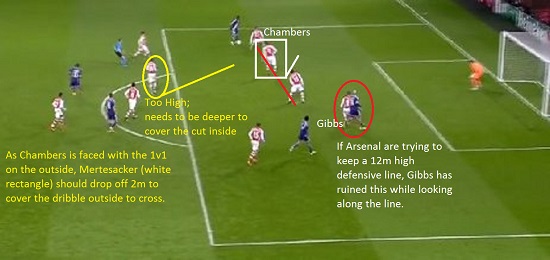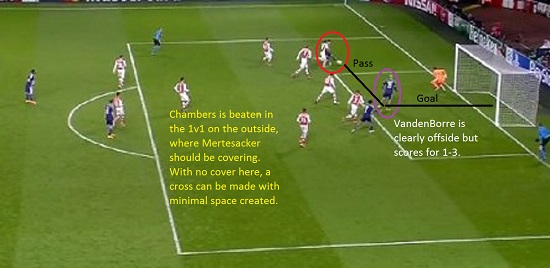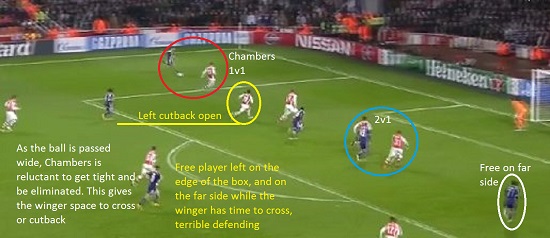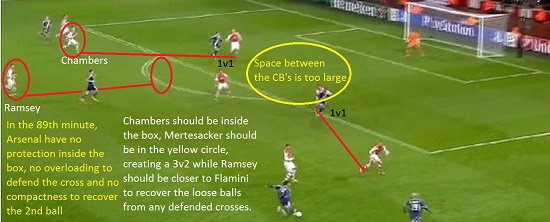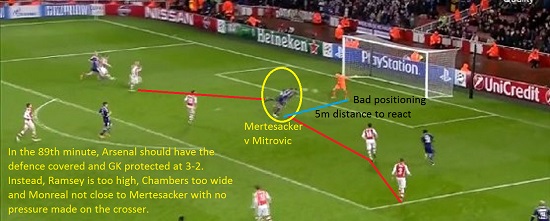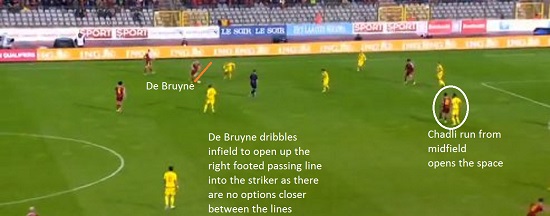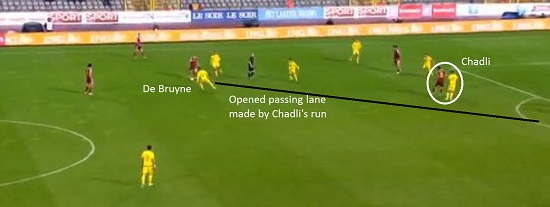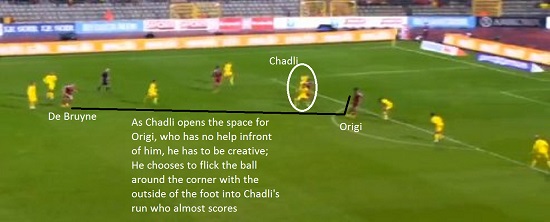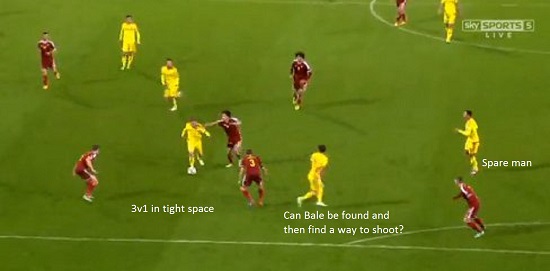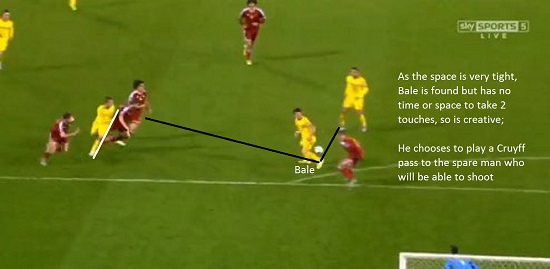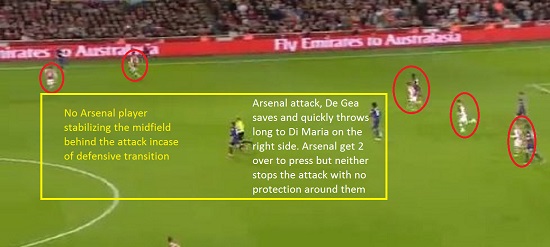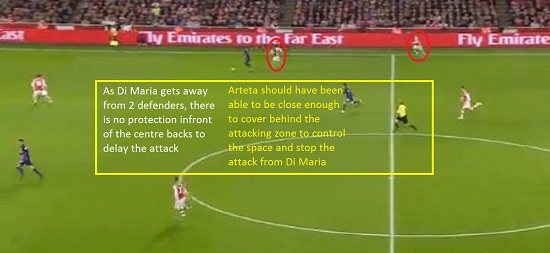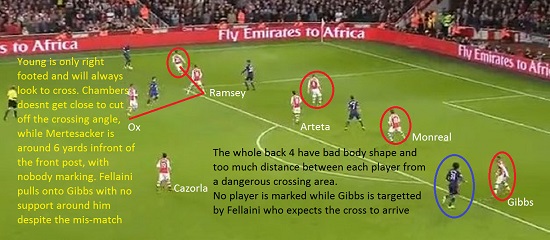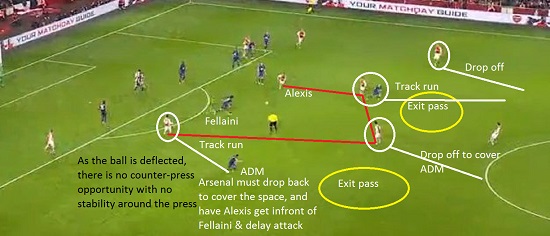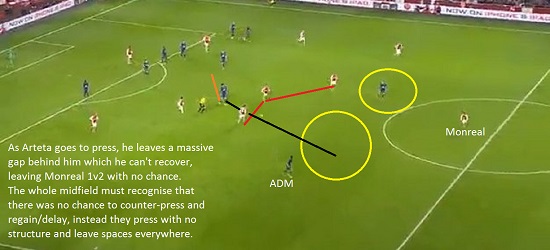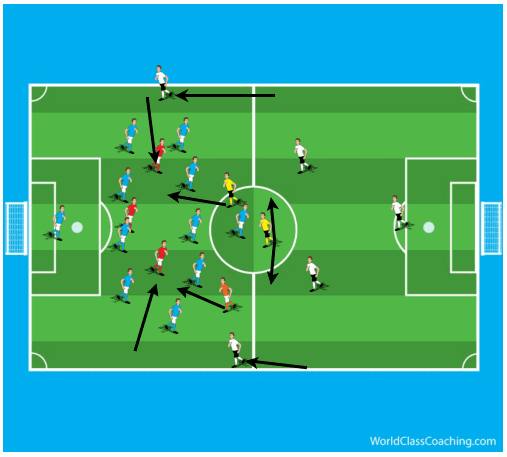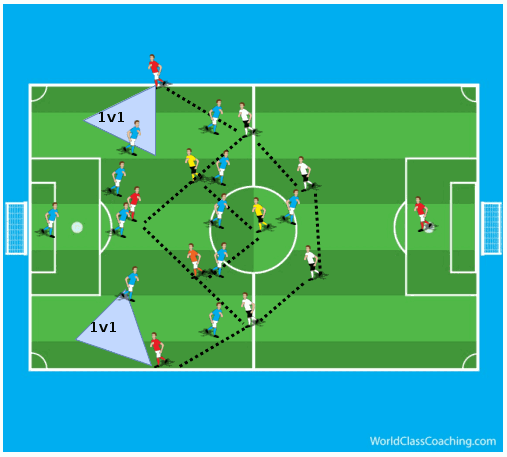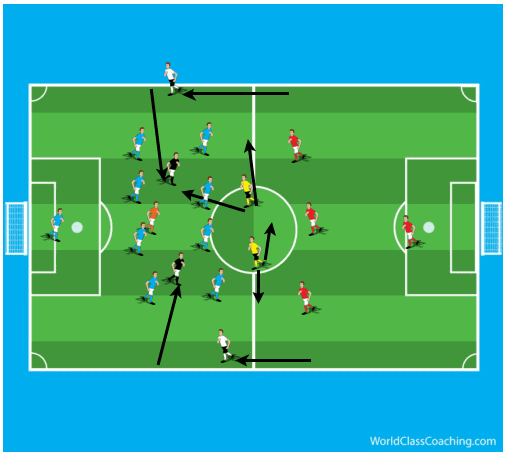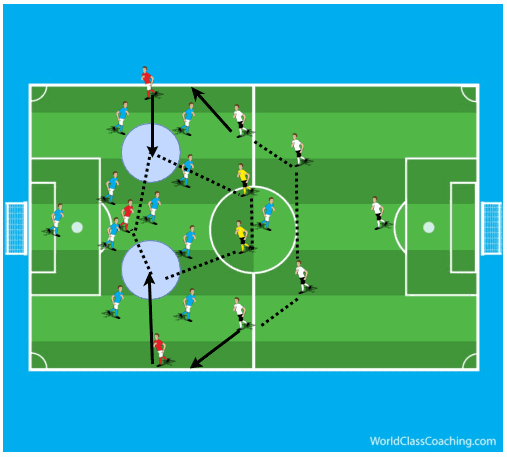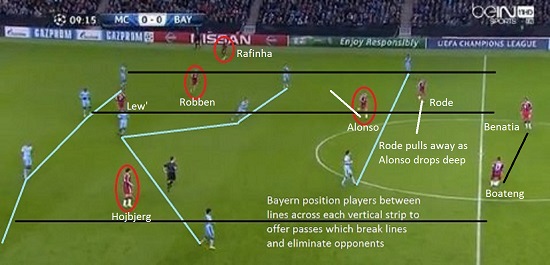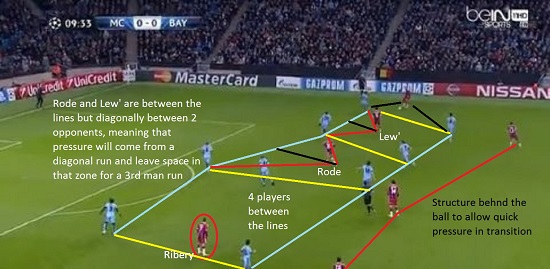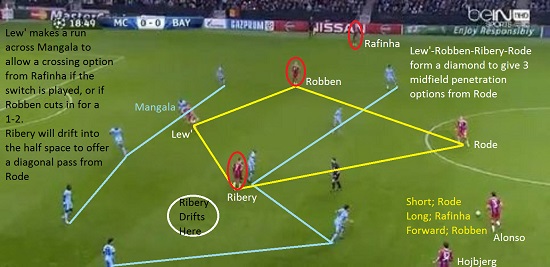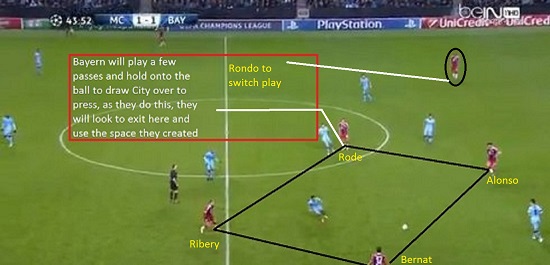Part Two
- Arsenal's Terrible Defending v Anderlecht
- Creativity to Create Goalscoring Chance
- Lack of Defensive Cover in the Midfield
- Bayern Munich's Positioning in Midfield
Arsenal's Terrible Defending v Anderlecht
Arsenal have been notoriously bad defensively for several years, but this looked to be changing in the past 18 months, Laurent Koscielny and Per Mertesacker becoming a solid partnership at the back as both players strengths complement each other’s weaknesses. In this game v Anderlecht, recognised 2nd choice left full back Nacho Monreal played at Centre Back with Per Mertesacker, in what was always destined to be a horror pairing, and so it turned out to be.
From the 1st whistle, neither player looked comfortable with the pairing, and in the 1st half, Anderlecht could’ve easily scored 3 goals, while Arsenal tore into a 2-0 HT lead.
In the 2nd half, Arsenal made it 3 through some excellent pressure in the Anderlecht half, but no more than 3 minutes later, it was 3-1 then 3-2, before the game ended 3-3 with an 89th minute goal.
Anderlecht 1st goal; Chambers 1v1 with no cover around him leads to offside goal conversion
Calum Chambers is a decent centre back, and almost definatly a better centre back than right back. One of the reasons for this is that he is a poor 1v1 defender and lacks pace to recover when the attacker slips away from him. In this situation, Mertesacker (white rectangle) needs to drop off 1m-2m and give some cover to the expected dribble outside to cross. If this happens, the cross can be stopped or cut out before the front post.
As Mertesacker doesn’t provide cover behind Chambers, the cross is allowed to be made. Despite the goal scorer being clearly offside, the attack should have been stopped before the ball reaches that position. If VandenBorre is not in this position, I think that the ball would’ve reached the far post and been scored as Gibbs does not know where his man is.
Anderlecht cutback chance – no midfield protection
Aside from the lack of positional accuracy and organisation inside the box, the midfield didn’t give the defence much protection, and this was evident throughout the match. In this example, Flamini runs needlessly into a position between Mertesacker and Chambers, while Chambers doesn’t want to get too tight as he is liable to be eliminated.
As the winger has time on the ball, and Flamini is in a terrible position to defend against a pass, there are 2 options; cross to the far post or to cut-back to the edge of the box. If Mertesacker was in a narrower position, closer to the front zone, this would free up Gibbs to play in the far post zone, able to attack a cross into 2 players.
Anderlecht 3rd goal
In the 89th minute, when you have lost a 3 goal lead, the game needs to be closed up. The back 4 stay compact and connected, the midfield provide protection and you force the opposition to break you down or play low percentage passes into the defence where you have a high chance of a regain to stop the attack (Jose Mourinho style).
Instead, Arsenal don’t do this, they stay open, and leave spaces all over the field. Here, there is no pressure on the player in possession, no protection of the goal – you need overloads here – and the far side FB is so far away from the 2nd CB that this means the whole back 4 is disconnected, resulting in 1v1s against the CBs. Ramsey needs to be closer to Flamini to help him cover more of the space between the CB’s and to track the runner into the box. Anything loose is easier to be recovered if there are two players rather than one.
As the cross comes into the space between Mertesacker and Monreal, Mitrovic wins the header and scores as Szczesny comes off of his line – reducing his reaction time to save the header – as Monreal is nowhere near close enough to have dealt with the cross as the 1st CB as the 2nd CB deals with the attacker 1v1.
This is a common trait of Arsenal in the past few years and is largely what stops them from getting close to winning the league or progressing to the last 8 or last 4 of the Champions League.
Creativity to Create Goalscoring Chance
One element in tactical development is the ability of players to do the unexpected to open up scoring chances. Tactics allow for the team to have a structured playing style which leads into a game process to find a way to win a game, but often a game is won by players in attacking areas making a chance to score from a piece of inspired play, often in tight situations.
Origi creates a chance for Chadli
De Bruyne dribbles inside to look for a diagonal pass into the feet of a player between the lines or into the last line of the defence. As he has Fellaini and Chadli infront but marked or screened, space needs to be created.
Chadli makes the space for Origi to receive
Chadli is marked between the lines, so drifts to the side of the ball, with his marker, creating a passing lane into the feet of the striker, Origi. As Origi drops in, Chadli will look to go behind.
Origi’s creativity finds the final pass to create a scoring chance
As Origi drops, Chadli is on the run beyond the defence. He expects that he has pressure from behind so passes quickly with an outside of the foot flick to add spin onto the ball to roll infront of Chadli behind the defence. The CB stays away as he must be expecting Origi to take a touch, then force him back and away from goal, then get the defensive line higher up.
Instead, Origi’s 1st touch is perfect and takes out the defence, but Chadli’ misses his chance to score.
Bale creativity to create a scoring chance
From a long ball, Bale knocks it down then peels away from his marker, his team mate recovers the ball but is in a tight 3v1 situation, and must release the ball. How can a scoring chance be made?
Bale finds the spare man in a shooting position with a Cruyff Pass
As the pass is made, Bale has to release the ball with one touch, as he has no time for 2. He reacts quickly and uses his high technical level to find a Cruyff pass to the spare man who has a chance to shoot from 20m, which results in a good shot on target which Courtois does well to save.
In this 0-0 against 2 well organised defences, the way through the defence was coming from a piece of unexpected flair to create a scoring chance, from both Origi and Bale.
In tactical development, coaches should embrace the players who have flair and can do the unexpected as these are the players who can win a game for the team from nothing.
Lack of Defensive Cover in the Midfield
In the last few seasons, Arsenal have tried to play a possession and pressing system, but often with massive instability, mainly through Mikel Arteta’s bad decision making at the bottom of the midfield triangle when deciding to press (and often foul) or drop off.
As he was always more of a controlling central midfielder than a deep playmaker in the #6 position, adjusting to this position in an attacking sense has been a lot easier than the defensive aspects needed for the role, such as pressing, covering, screening passes into strikers, tracking runners and offering protection to centre backs.
In the recent game against Manchester United, the lack of stability in the Arsenal midfield out of possession was again evident, particularly when pressing, and often with no stability around or behind the pressing zone.
Example; Rooney’s goal for 2-0 in the 86th minute
In this image, the ball is rebounded to the central midfielder. Above the dotted line, there is only 1 player able to confront the ball carrier and delay play, and not from a weak side position. This dictates that
the press is not possible and the deepest players in the vicinity should simply retreat into deep positions and not allow the ball into the gaps behind the players in the pressing vicinity.
Ideally, the team in defensive transition (black) will drop off and track the runners, and get as many people into a defensive shape 40m-30m from goal then become organised.
Instead, Arsenal presses with no stability behind the press. If there was an opportunity to press, there would be 2 covering players along the dotted red line, covering the exit routes away from pressure. As there are no players covering, the pass behind the press results in a 2v1.
This has been a common feature for the best part of 3 seasons and until Arsenal can become co-ordinated in the pressing actions, they will not get anywhere near winning the Premier League or Champions League.
Positioning Behind the Ball in Attacking Phases
When attacking a low block, there needs to be small distances to retain possession and provoke the defence to come out and press to leave space. This also applied to when the ball is lost, particularly against a team with fast players on the sides, players like Angel Di Maria.
Here, Arsenal lose the ball and have 4 players forward, both full backs high and wide, and no cover in central midfield. As the ball is thrown wide, Arsenal have no protection in central midfield, Di Maria is in the space of the advanced full back so as the long throw is made, Gibbs cannot recover and Arteta is well out of position. As Di Maria receives, he can dribble 1v1 or pass inside and have a clear run through the centre at Arsenal’s exposed centre backs – neither of whom are comfortable with a high line.
In the offensive phase, Arteta should be covering behind the ball and be able to anticipate when he wil be needed 2 passes ahead of time, and be able to see where the danger will come from if the ball is lost. He doesn’t, and as a result Manchester United have a clear counter attack.
No Marking or prioritization of danger when dealing with wide attacks
Arsenal know that Ashley Young is only going to cut back and cross, and will likely look for Fellaini. As no Arsenal player has the correct body shape to see the movements of each attacker or each other, they have no idea that Gibbs is left with Fellaini and no help around him.
Arteta’s position is between the CB’s who are too far apart; Mertesacker is worried about the reverse pass to Van Persie and wants to get over and press – this should be Ramseys job – while neither Arteta or Monreal mark Di Maria. Monreal really needs to be closer to Gibbs, so Arteta should take Di Maria while Ox can cover the edge of the box with Cazorla. As this happens, the cross to the back post is made, Szczesny comes out to attack the ball and can only make a small punch, Valencia arrives untracked and blasts the ball across goal which Gibbs turns in. This would often be regarded as ‘unlucky’ but this is the sort of soft goal Arsenal lose regularly through a lack of defensive positioning and organisation between players.
Pressing when unstable around the pressing zone
As the image at the top shows, there is no way that an effective counter-press can be made here, with 2 clear exit routes for Fellaini. As Fellaini regains the ball, he can wait to see the defensive action of each Arsenal player before choosing his pass.
- If they all press; he will release behind short and to feet, an easy pass.
- If they drop off; he has a more difficult ball over the top which may have more pressure when receiving on the side and with cover inside from Arsenal.
Arsenal press with no stability around or behind the press, leaving themselves open to a 2v1.
Overall, Mikel Arteta may have a high pass completion rate but his decision making when to press or to drop off is a large reason why Arsenal have looked so poor out of possession for a long time, and until the tactical system is adapted to protect the defence better, Arsenal will struggle in big games.
Bayern Munich's Positioning in Midfield
Bayern initial set up – 4-2-3-1/4-3-3 hybrid
With Alonso (yellow) screening infront of the defence and playing laterally, this allows Rode (yellow) and Hojbjerg (orange) to be free to drift between the lines and support if Robben or Ribery (Red) stay wide. If they stay wide, Bernat/Rafinha stay deeper and tuck inside as inverted FB’s and help overload centrally to look for forward passes through the defence.
Bayern 4-3-3 with 1v1 zones on the side and inverted full backs
As Robben and Ribery are excellent 1v1 players, staying wide opens up a lot of space in the centre, allowing Hojbjerg and Rode free to drift between the lines on the far side and offer supporting runs in the half spaces. As Bernat and Rafinha stay narrow, the back 4 are in set transition areas to counter-press or drop deep. Alonso can cover infront or between the CB’s to make a back 3, 4 or 5.
If Alonso (red centre) dropped between the CBs as both FB’s were high (white), then Rode and Hojbjerg would play in central midfield with Robben and Ribery (black) drifting between the lines as Lewandowski (orange) stays high, with the FBs on different lines – Bernat deeper on the left than Rafinha on the right.
Bayern down to 10 men – 4-4-1 defence, 2-4-3 attack
When Bayern lost Benatia, Dante came on for Rode, so Bayern made a pentagonal central shape when the FBs could push high, and become a 2-2-4-1/2-4-3 formation, specifically looking to hit the spaces circled with Ribery and Robben asked to dribble and eliminate players using the outside players as a safety net to keep possession.
Positioning between the lines
With the ball in the back line, we have Alonso dropping deep to receive in the central space, with Rode pulling wider to offer a pass into the half space in the channel to go direct to Robben with a straight pass. Hojbjerg offers a diagonal pass from the centre in the half space in the central zone.
Robben has a good partnership with Rafinha, and will offer a diagonal pass from Alonso with Rafinha likely to run behind to stretch the defence and given Robben time to dribble inside or pass behind.
Players between the lines, diagonally between opponents
As Rafinha is in possession, he has 3 other team mates between the lines, all diagonally between opponents. This means that pressure comes from a diagonal run, leaving space which can be easily exploited with quick passes that evade pressure and particularly from blindside, 3rd man runs.
The 3 players behind the ball provide structure to allow for a counter-press, while being technically capable of playing in possession this close to the opponents, who will likely drop back as Rafinha passes inside.
Diamond structure from the centre of the field while offering penetration between the lines
As Alonso is in possession in the channel, Rode occupies the centre with the best range of attacking passes available to him. Alonso has 3 clear options; a short pass to Rode, Long to Rafinha or forward to Robben via a chipped pass or between the central midfielders if he drifts inside a little more.
If the ball is switched, Lewandowski is already on the move to play on the blindside, leaving space for a 1-2 from Robben or if Rafinha receives, to give Robben more room to dribble into diagonally, or to offer a crossing option from Rafinha.
Ribery is already marked but if the ball is passed to Rode, he will drift into the gap circled, leaving a new passing angle into an area where Ribery’s 1v1 ability can prove decisive.
Lewandowski goal – Rondo to switch
With Benatia sent off, Bayern need to eliminate the extra man that City have while in possession. Here, they move the ball wide and play extra passes to draw over pressure, then switch to the far side. Here, Rode drifts away as the 3v2 is made, with Rode between the lines, City drop deeper. This leaves space for the switch to Boateng who receives and crosses for Lewandowski v Sagna who scores.
A key feature of Bayern’s play is the positioning in the channels to receive and penetrate via the half spaces, while every player knows which zones need to be occupied to provide overloads centrally, while the distribution of Alonso and Boateng from deep, particularly into Ribery and Robben who has excellent dribbling abilities, which often prove decisive against tight defences.
Against Man City, their control of possession with 11v11 was to be expected, but with 10v11 it shows the level of bravery of Guardiola to continue looking for solutions and a way to score more goals.

